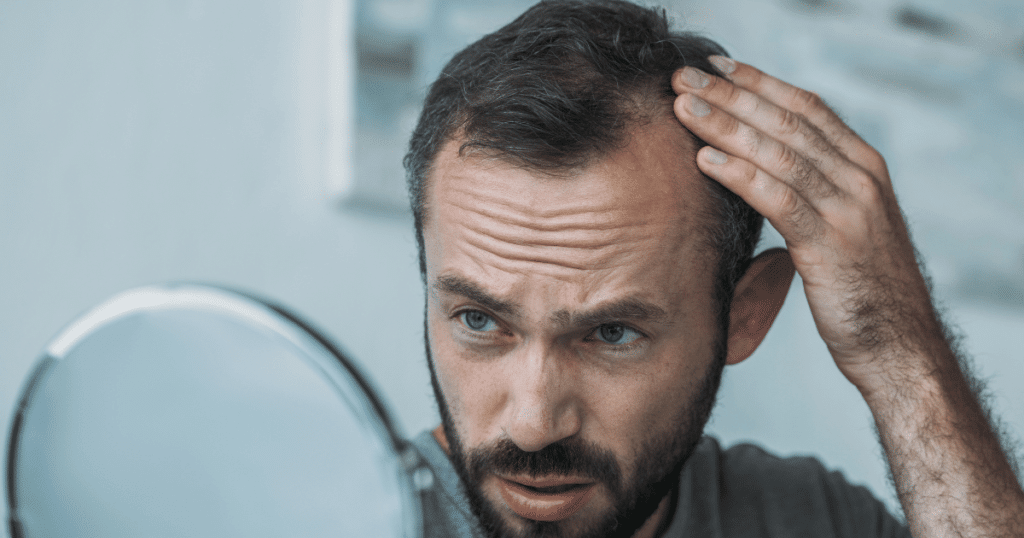In a world where a full head of hair is often associated with youth and vitality, the reality of hair loss can be a difficult pill to swallow.
The quest for reliable information and effective hair loss treatments has led many individuals to seek out innovative solutions. As a result, Platelet-Rich Plasma (PRP) hair growth treatments have emerged as a significant player in the field.
PRP, a procedure that uses your own blood to promote hair regrowth, is gaining traction. This blog post aims to provide you with comprehensive PRP info, looking into the causes of hair loss, the science behind PRP, and what the PRP hair restoration process entails.
If you’re grappling with hair loss and are eager to explore effective treatments, this post is for you. So, keep reading as we unravel the mysteries of PRP and its role in hair restoration.

Understanding Hair Loss
Before we delve into PRP and its effects, let’s first understand the enemy we are fighting – hair loss. Hair loss can be attributed to several factors:
- Androgenetic Alopecia: Also known as pattern baldness, this type of hair loss is genetically influenced and tends to follow a pattern.
- Hormonal changes: Conditions like thyroid disease, pregnancy, and menopause can also lead to hair loss.
- Medical conditions: Certain diseases, such as lupus and diabetes, can cause hair loss.
- Medications and surgeries: Treatments for cancer, depression, arthritis, and heart problems can result in hair loss.
Hair loss isn’t just about aesthetics. It can carry heavy emotional impacts, such as:
- Self-esteem issues: Hair loss can impact confidence, leading to feelings of unattractiveness and premature aging.
- Social anxiety: Those experiencing hair loss often feel self-conscious in social settings, fearing judgment or ridicule.
- Depression: In severe cases, hair loss can lead to depression due to persistent stress and anxiety over the condition.
What is PRP?
Platelet Rich Plasma, often referred to by its acronym PRP, is a substance derived from your own blood that has concentrated healing properties. Let’s break down what PRP is, how it’s derived, and its role in medical procedures:
- Definition: PRP is a concentration of platelets, a type of blood cell, in a small volume of plasma, the liquid part of your blood.
- Derivation: PRP is obtained through a simple blood draw. The blood sample is then placed in a centrifuge, a machine that spins at high speeds to separate the blood components. The platelets and plasma are separated from other blood cells, resulting in platelet-rich plasma.
- Role in medical procedures: PRP has a wide range of applications in the medical field. It’s been used to promote healing in musculoskeletal injuries, including joint and nerve injuries, and in cosmetic procedures like plastic surgery and dermal fillers. The growth factors in PRP stimulate cell growth and tissue regeneration, making it a valuable tool in a variety of treatments.
How Does PRP Work for Hair Growth?
Now that we understand what PRP is, let’s delve into the science behind PRP hair growth:
Tissue regeneration and wound healing
Platelets are known for their role in blood clotting, but they also release growth factors that contribute to tissue regeneration and wound healing. When injected into the scalp, these growth factors may stimulate the activity of the hair follicles and promote new hair growth.
Activation of dormant hair follicles
PRP is believed to move hair follicles from a dormant state into an active hair growth phase. This shift could increase the density of hair growth and the diameter of hairs, enhancing hair thickness and volume.
Why PRP for hair restoration?
PRP is considered for hair restoration due to its potential to increase hair count and reduce hair loss without major side effects. It’s a minimally invasive procedure compared to other treatments like hair transplantation. Moreover, because PRP uses your own blood, there is no risk of disease transmission, allergic reaction, or rejection.
PRP therapy is becoming increasingly popular for hair restoration, and while more scientific evidence is needed to fully understand the effectiveness of PRP for all types of hair loss, initial results are promising. Whether you’re dealing with female pattern hair loss, thinning hair, or other common conditions, PRP could be a viable solution for your hair loss.
PRP Hair Restoration: What Does the Procedure Involve?
Let’s demystify the PRP hair restoration process. Here’s what you can expect:
- Consultation: The journey starts with an initial consultation. Our medical intake staff will assess your hair loss, discuss your medical history, and determine if you’re a good candidate for PRP. Factors like the type of hair loss, hormone levels, and overall health will be considered.
- Preparation: If you’re deemed a suitable candidate, the clinic will schedule your first session. Prior to the treatment, you may be asked to avoid certain medications and maintain good hydration.
- Blood Draw: On the day of the procedure, a small amount of your blood will be drawn, similar to a standard blood test.
- Separation of Platelets: The blood sample is then placed in a centrifuge to separate the platelet-rich plasma from the other blood components.
- PRP Injection: The PRP, now rich with concentrations of platelets and growth factors, is then injected into areas of your scalp where hair growth is desired.
- Post-procedure Care: After the procedure, you’ll receive instructions for post-treatment care. This may include avoiding strenuous activities for a few days and using gentle hair products.
The entire process takes about an hour, and most patients can resume their normal activities immediately. Minor side effects such as scalp tenderness or temporary bleeding at the injection sites are common but usually subside within a few days.
What to Expect After a PRP Hair Restoration Treatment
After undergoing PRP hair restoration, it’s important to know what to expect during the recovery period. Here’s a brief rundown:
- Immediate Aftermath: The treatment area may be sensitive, and some patients experience minor discomfort or swelling. These symptoms usually subside within a few days.
- Recovery: There’s minimal downtime with PRP. You can typically resume your regular activities immediately, but it’s advisable to avoid strenuous exercise and alcohol for at least 24 hours post-treatment.
- Side Effects: Side effects are generally mild. They can include temporary bleeding, scalp tenderness, or slight swelling at the injection sites. In rare cases, patients may have an adverse reaction to the PRP injections, such as infection or tissue damage. Always report any concerning symptoms to your medical professional.
In terms of results, patience is key. Hair growth is a slow biological process, and it usually takes several months to notice significant changes. Here’s a typical timeline:
- 2-3 Months Post-Treatment: You may notice a decrease in hair shedding.
- 3-6 Months Post-Treatment: Initial signs of new hair growth can be expected around this time.
- 6-12 Months Post-Treatment: By this time, many patients see a noticeable improvement in hair density and volume.
Do note that results vary from person to person, and multiple sessions (usually 3-5) are often recommended for optimal results.
Is PRP Right for You?
PRP can be a good option for many people experiencing hair loss, but it’s not for everyone. Ideal candidates for PRP are those in the early stages of hair loss or have androgenetic alopecia, a common form of hair thinning that affects both men and women.
However, PRP may not be as effective for those with:
- Complete baldness
- Hair loss due to medication, such as chemotherapy
- Active scalp infections
If you’re considering PRP, your first step should be to schedule a free consultation with our staff, or a medical professional experienced in hair loss treatments. We will happily provide more PRP info, assess your condition, and recommend the best course of action for you.
Patient Outro
Remember, the decision to pursue any treatment is a personal one. It’s crucial to weigh the potential benefits against the costs and possible side effects. With the right guidance and realistic expectations, PRP can be a game-changer in your hair restoration journey.
Your journey to hair regrowth starts with a single step. Reach out to Laserbody MD today, and take that step towards fuller, healthier hair. You owe it to yourself to explore every option – and PRP could be the solution you’ve been searching for.
















